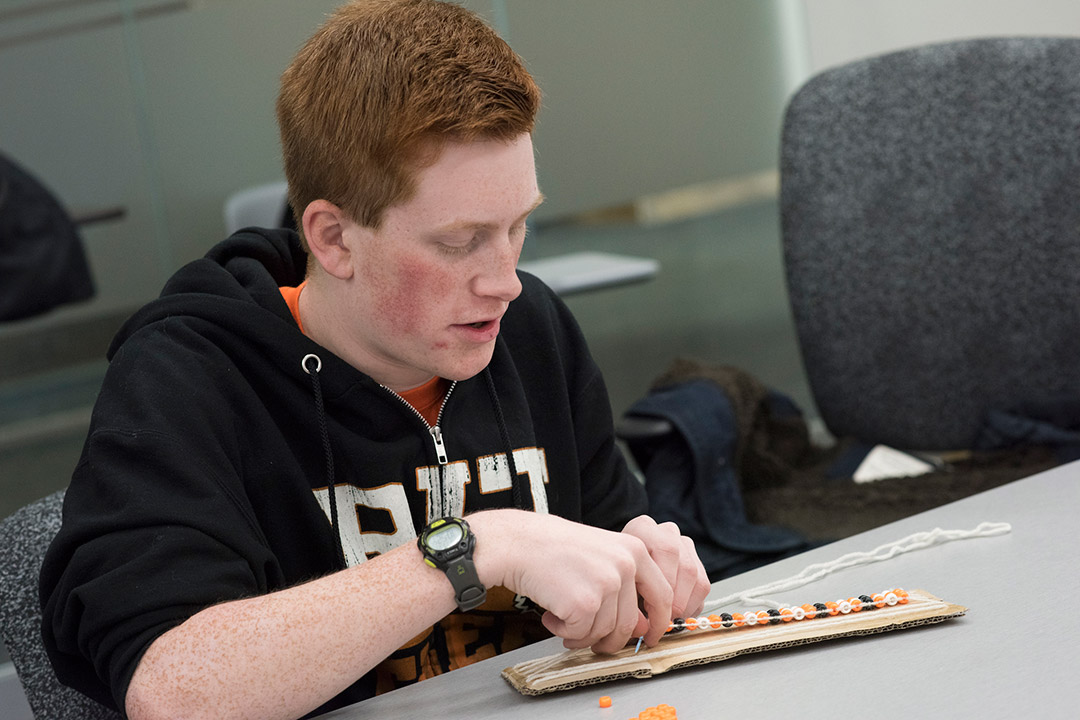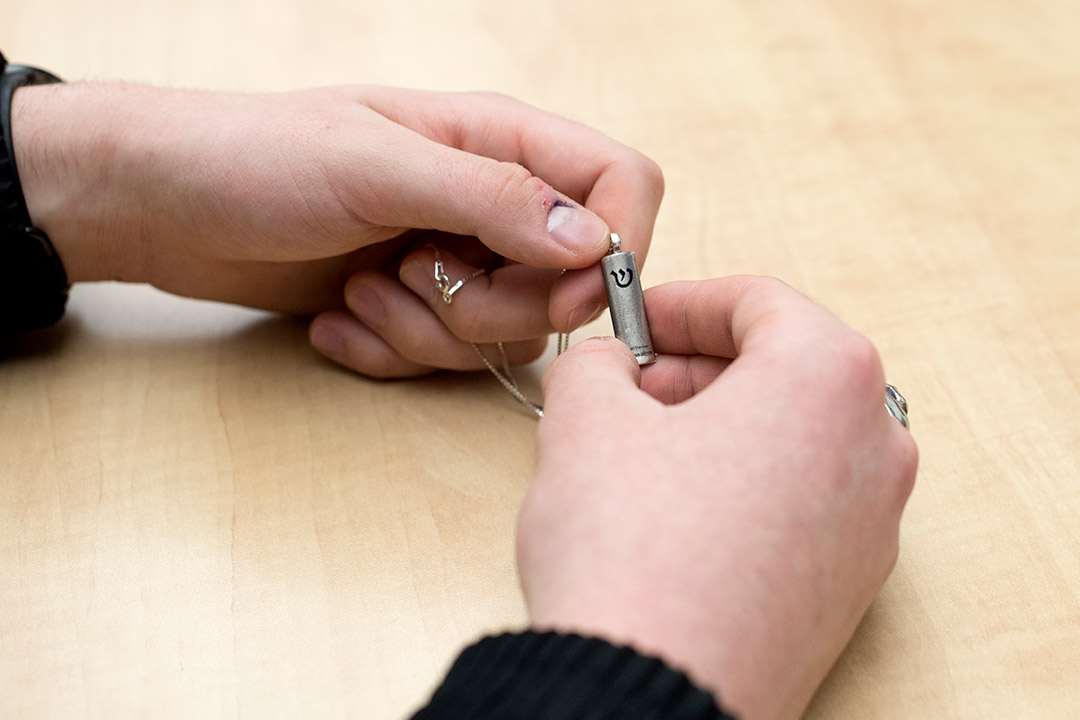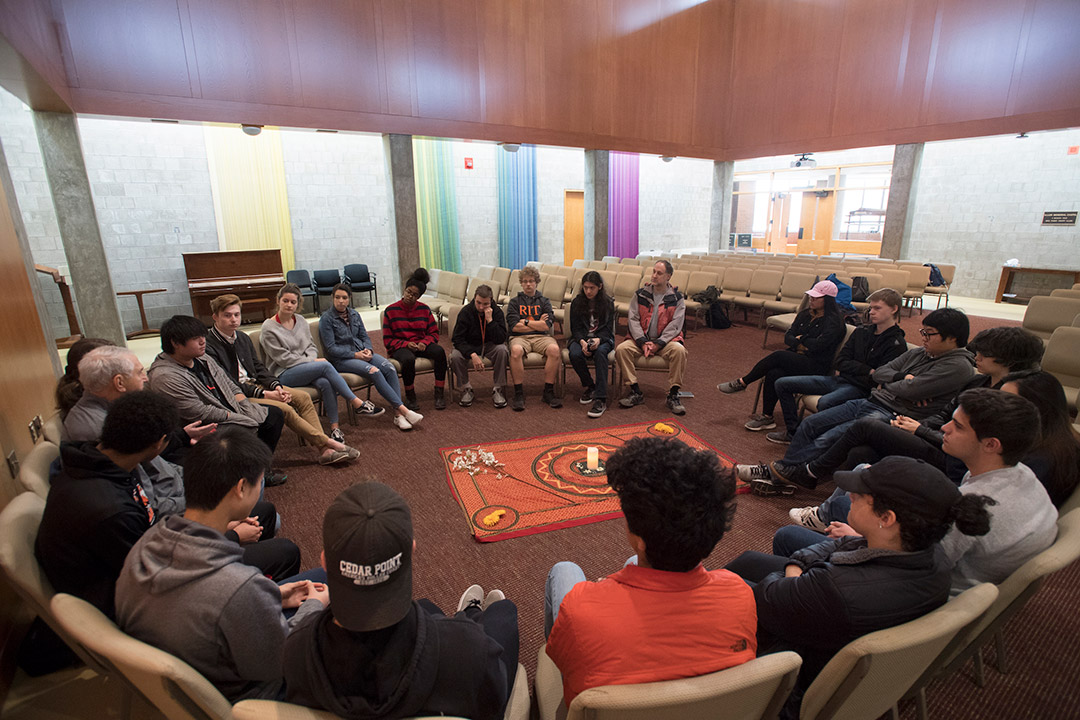RIT 365 teaches first-year students more about RIT, and themselves
Students exposed to reflection opportunities, diverse cultures, maker spaces and study abroad
A. Sue Weisler
First-year students learned about themselves and their fellow students during an RIT 365 session in the Schmitt Interfaith Center for an existential discussion.
A college student’s first year on campus can be adventurous, exhilarating, challenging, academic, rewarding and even a bit scary. To help make that transition into higher education a bit easier, Rochester Institute of Technology has started an innovative program to help students discover how they can be active on campus and engage with new people and places.
Called RIT 365, the program, believed to be the first of its kind, is intended to provide exposure to educational and social opportunities within a framework of reflection, self-awareness and community. Some 2,600 first-year students met weekly all over campus, from visiting a cadaver lab to a glass blowing studio. They encountered others with diverse cultures and were able to consider study abroad options. They then reflected on these experiences in facilitated dialogue with their classmates.
“It helps them understand RIT in a broader sense,” said Stacy Nation-Knapper, director of Year One Programs at RIT. “They may not have known there was a glass lab on campus, a whole arts culture on campus. Why is there a glass lab at RIT? What would you do there? This helps them understand the community they are in and facilitates the pathways they choose for themselves. We’re introducing them to a whole array of things available to them.”
Previously, first-year programs at RIT – and many other colleges – taught new students survival skills such as how to enroll in classes and manage their time, skills students often have when they arrive on campus.
Each RIT 365 class had up to 24 students of varying majors; no more than 10 students from the same college could be in a group. More than 100 second-year or higher undergraduates were also involved, helping facilitate the classes and sessions to reflect upon those experiences.
In 115 sections of the class, students engaged in experiential opportunities based on themes they ranked by preference: creativity, entrepreneurial, technology and society, well-being, innovation and global citizenship.
 A. Sue Weisler Mike Buffalin, (standing), manager of The Construct, shows students (left to right) Cheyenne Williams, a diagnostic medical sonography major from Rochester; Jack Buell, a mechanical engineering technology major from Plymouth, Pa.; and Darlene Ardila, a computer exploration major from Holyoke, Mass., how to use a biofeedback device to measure heart rate during an RIT 365 session.
A. Sue Weisler Mike Buffalin, (standing), manager of The Construct, shows students (left to right) Cheyenne Williams, a diagnostic medical sonography major from Rochester; Jack Buell, a mechanical engineering technology major from Plymouth, Pa.; and Darlene Ardila, a computer exploration major from Holyoke, Mass., how to use a biofeedback device to measure heart rate during an RIT 365 session. Students interested in entrepreneurship visited The Construct on the fourth floor of Institute Hall, where they got to look at their heartbeats on a biofeedback computer program and see where they could use 3D printers.
“We want to expose them to the maker’s space,” said Mike Buffalin, manager of The Construct. “We want them to come back in some form or another, whether they are doing a capstone project, a club activity or just a personal project. If they just want to come and play, that’s perfectly fine.”
Buffalin told them about a new $500 challenge offered by RIT to help students turn ideas into reality.
“Maker spaces are popping up all over the country,” he said. “About 70 percent of the U.S. economy is based on service-based business, as opposed to manufacturing. The government hopes to change that.”
To help commemorate Native American Heritage Month in November, some of the students attended a session to learn about wampum and used colored plastic beads make their own decorative belts.
“I thought talking about the history of treaties would be appropriate,” said Nicole Scott, director of RIT’s Future Stewards Program.
Rich Hamell and Aimee Carpenter from the Ganondagan State Historical Site explained to students that wampum belts were used not to wear, but to greet visitors to Native American villages. Hamell showed a string of wampum that was created around 1640, made of purple and white shells, the colors of the Haudenosaunee people.
“These belts are sacred documents,” Hamell said.
 A. Sue Weisler Greg Paiement made a wampum belt with orange, white and black beads and planned to hang it in his room.
A. Sue Weisler Greg Paiement made a wampum belt with orange, white and black beads and planned to hang it in his room.Greg Paiement, a computer science major from Fairport, N.Y., made his wampum belt with orange, white and black beads and planned to hang it in his room.
“I thought it was interesting what they were used for by Native Americans,” he said.
The students also learned more about themselves and their fellow students. In another session, students gathered in a circle in the Schmitt Interfaith Center for an existential discussion.
In sessions about culture, students were told to bring items of significance to them. Students brought chopsticks, headphones, even pizza slices.
 A. Sue Weisler Mason Lapine shows fellow first-year students his mezuzah, which contained specific Hebrew verses from the Torah.
A. Sue Weisler Mason Lapine shows fellow first-year students his mezuzah, which contained specific Hebrew verses from the Torah.Mason Lapine, a computing exploration student from Stamford, Conn., took off his necklace and showed his mezuzah which contained specific Hebrew verses from the Torah.
“I wear it every day,” he said. “It reminds me what values I have.”
Paavo Hegley, a mechanical engineering technology major from New York City, held up a postage stamp.
“I have family spread around the country, and this reminds me of just how important family and communication is,” he said.
 A. Sue Weisler Paavo Hegley showsd a postage stamp to fellow first-year students when asked to bring an item that had meaning to him during an RIT 365 session. He said his family was spread around the country and the stamp reminds him how important family and communication is.
A. Sue Weisler Paavo Hegley showsd a postage stamp to fellow first-year students when asked to bring an item that had meaning to him during an RIT 365 session. He said his family was spread around the country and the stamp reminds him how important family and communication is.Taylor Liotta, a biomedical sciences major from Mississauga, Ontario, brought a hockey puck. She explained she’s a goalie on the RIT women’s hockey team.
“Hockey has been a huge part of my life and has given me the chance to meet so many people and travel around the world,” she said.
RIT’s leadership and faculty are supporting RIT 365, which will act as a possible feeder to introduce students to their classes, labs and resources. In the spring semester, the students will be invited to join programs on campus that can include service learning.
“They get to start making choices in how they contribute as a member of the community,” Nation-Knapper said. She said several of the students also began selecting minors they’d like to pursue because of their exposure to the programs.
 A. Sue Weisler Taylor Liotta shows fellow first-year students a hockey puck, an item she said had a lot of meaning to her as she’s a goalie on the RIT women’s hockey team.
A. Sue Weisler Taylor Liotta shows fellow first-year students a hockey puck, an item she said had a lot of meaning to her as she’s a goalie on the RIT women’s hockey team.Liotta reflected on her RIT 365 experiences, especially discussions with other students she’s met in her class.
“It has exposed me to new cultures here and allowed me to meet people from all over the world,” Liotta said.
After the students talked about their items, they heard from RIT Global’s study abroad team about how to collect new experiences, refined values and new ways of being and knowing.
Jack Buell, a mechanical engineering technology student from Plymouth Meeting, Pa., said his favorite RIT 365 exercise was interviewing one of his professors.
“It felt more personal,” Buell said. “I had to put effort into it.”













